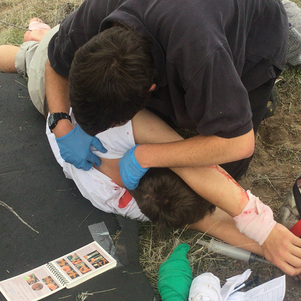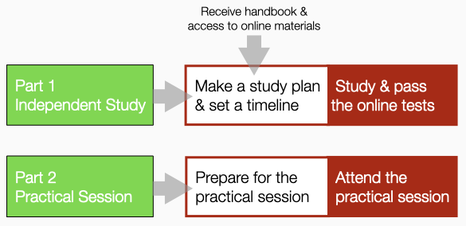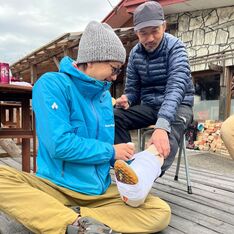What to Expect During a WMTC Course
|
GOALS & RESPONSIBILITIES
Understanding the student and instructor roles will help students take an active part in learning the course material. Both students and instructors share the following goals:
Participation & Attendance expectations
Students must attend, be engaged in, and fully participate in all sessions; complete attendance and focus are required to pass the course and be eligible for certification. Students who miss any portion of the course will not receive a full 3-year certification. Based on a combination of variables— the amount and content of the missed portions and the student's demonstrated skill level at the end of the course — instructors may award a shorter or lower-level certification. We encourage students to arrive well-rested and have minimal or no outside obligations during the course. Evaluation & CERTIFICATION STANDARDS
To receive certification, students participating in a certification course must meet a set of predetermined standards to receive certification. Evaluation during a standard course or the practical session of a hybrid course is an ongoing process that begins when a student walks through the door and ends with graduation. All Standard courses—except WFA courses—have a final in-class written exam; students must score 80% or greater to pass. Part 1 hybrid students must pass a series of online exams before attending the Part 2 practical session; however, they should keep in mind that there will be evening case studies and worksheets throughout their practical session. Instructors do their best to offer timely and practical feedback throughout the course; students are encouraged to request additional feedback at any time. Instructors typically assign, collect, review, and evaluate case study homework, quizzes, and worksheets. Failure to complete and turn in assignments may result in not being awarded a certification or receiving a shorter or lower-level certification. Many students feel overwhelmed in the early part of a course. These feelings are normal. It takes time for the concepts to sink in. We encourage students to talk with instructors if they become overwhelmed and concerned about their progress. A DAY IN THE LIFE
WMTC wilderness medicine courses are dynamic, challenging, immersive, and a whole lot of fun. Check out the course syllabuses to get an idea of the topics and skills covered each day. The fundamental difference between a standard and a hybrid course is that in a standard course, an instructor presents lecture topics in person, and in a hybrid course, students learn the same material online. A "typical" day in a standard course alternates between lectures, case study reviews, skill labs, and simulations. Mornings tend to be devoted to case study reviews and lectures, while afternoons— and occasionally a full day — are dedicated to skill labs and simulations. Because Part 1 of a hybrid course addresses didactic material, the Part 2 practical session — as its name implies — is significantly more active with mornings, afternoons, and even some evenings filled with skill labs and simulations. Sessions in both formats are progressive and build smoothly on one another as the course progresses. LECTURES
While instructor-led lectures are unique to standard courses, hybrid students learn the same material online. Both formats, although different, are engaging and teach normal anatomy and physiology before diving into the pathophysiology of a problem. This progression helps students connect their patient's signs, symptoms, and pathophysiology to their assessment and treatment — to understand what's happening inside their patient's body and how to intervene effectively. Instructors use video, acting, short quizzes, stories, and mini-case studies to further explain lecture topics. Most students leave a presentation having experienced an "Ah-ha!" moment. We encourage students to ask questions. Questions and their answers are important, and most, if not all, students have many questions en route to mastering the course material. At the same time, we need them to understand that questions are a double-edged sword. Straightforward, well-timed questions usually benefit everyone. Poorly thought out or poorly timed questions often confuse the issue further while taking valuable class time. If an instructor doesn't know the answer to a student's question, they will say, "I don't know," and may venture an educated guess based on their knowledge of anatomy, physiology, and pathophysiology; ultimately, they will research the topic and return with an answer. We know that students can't remember or apply the information presented the first time they hear it. That's why key points are repeated again and again throughout the course in case studies, worksheets, quizzes, skill labs, and simulations. While students don't have to remember all the details of a topic as an instructor is speaking, they must understand the underlying concepts. Finally, our field manual is not "just" a book, and our patient notes are not paperwork — they are well-crafted tools designed to guide students step-by-step through the assessment process. At some point, it all clicks, usually during a simulation. SKILL LABS
Like lectures, skill labs are a prerequisite for simulations. We encourage students to focus their questions on the skills taught during skill labs and when to use them. Students may need to practice new treatment skills outside of class before using them in simulations or real life. SIMULATIONS
Students learn the most during simulations — it's where everything comes together or falls apart. There is value in both. Mistakes are a natural part of the learning process. The goal is for students to learn from their mistakes (and the mistakes of their fellow students). Ideally, everything falls into place by the end of the course. Simulations begin on the first day as the Basic Life Support (BLS) Skills Lab leads into BLS Simulations and, from there, into longer, more complex simulations that require students to complete and document their patient's signs and symptoms together with their assessment and treatment. Students use our field manual and patient notes to keep them on track. As the course progresses and instructors introduce new topics and skills, the simulations get progressively more difficult. WFR and WEMT courses often end with a mass casualty simulation. Simulations ALWAYS occur outside in a realistic environment where each student— or student group — has access to a well-stocked first aid kit and expedition equipment (sleeping bags, pads, packs, tarps, ski poles, oars, sticks, etc.) appropriate to the scenario. There are four phases to each simulation:
Simulation Guidelines
TESTING & EXAMS
All Standard courses—except WFA courses—have a final in-class written exam; students must score 80% or greater to pass. Talk with the WMTC Office or instructors about any potential testing accommodations. We can't always accommodate all testing requests, so please discuss your concerns with our office before registering for a course. Part 1 hybrid students must pass a series of online exams before attending the Part 2 practical session; however, they should keep in mind that there will be evening case studies and worksheets throughout their practical session. Students who have a large gap between the time they complete Part 1 and begin Part 2 will receive access to an online Review test two weeks before the start of their practical session; the test refreshes critical concepts learned during the Independent Study. Students may review their Part 1 tests until their subscription expires; they will have access to the course website through the practical session. "This is a hard but rewarding process that I would recommend to any outdoor enthusiast." |






